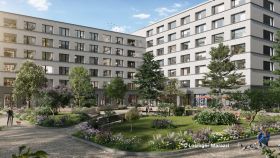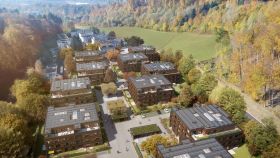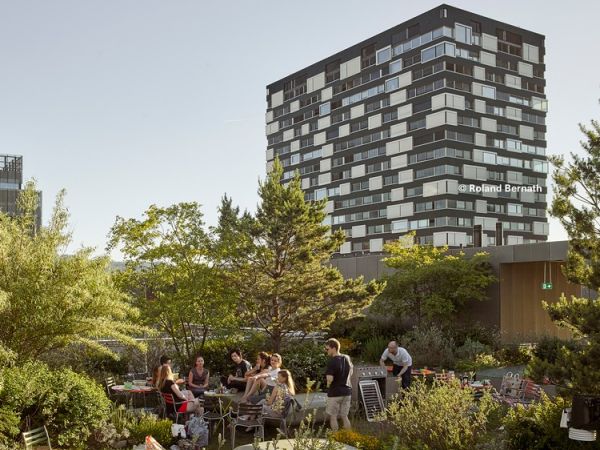
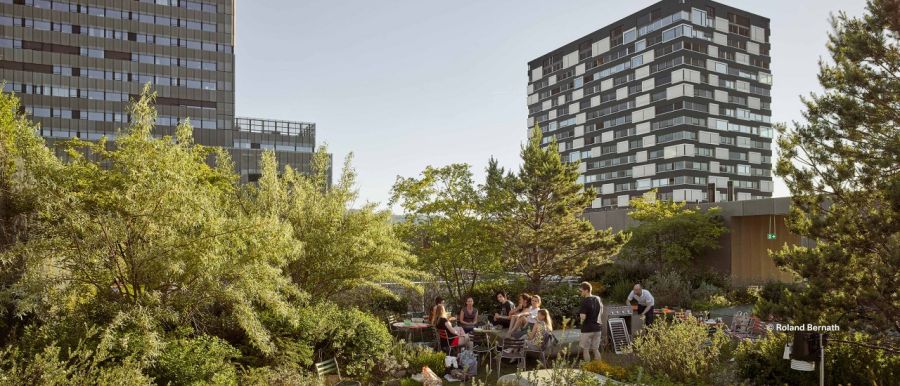
How should we be building today so that buildings can cope with the climate of the future? Our ‘Climate-conscious building’ white paper provides building owners and investors with a knowledge base and inspiration for building against the background of climate change and shows what a renewable energy supply can look like.
Recent summers have given us all a clear glimpse of what it will mean if it continues to get hotter and drier in our latitudes. Temperatures in Switzerland have risen significantly since 1864. According to MeteoSwiss, the mean annual temperature is now around two degrees higher than when records began. And there is no doubt about it: temperatures will continue to rise. By how much, however, remains to be seen. This will largely depend on whether we can stop, or at least slow down, anthropogenic global warming.
Cities heavily affected
Climate change is particularly noticeable in cities, as they are densely populated and have a high proportion of sealed surfaces. Green spaces with shady trees and cold air corridors intended to bring cooling are often either entirely absent or inadequate, meaning heat islands form in urban areas – where temperatures can be up to ten degrees higher at night than in surrounding areas. A catalogue of measures tailored to each specific location is needed to counteract this heat island effect. The most important principles for climate-conscious urban planning and building include:
- Building position and sizing: Building positions must be devised to promote natural air exchange.
- Green spaces: Dense vegetation, ideally with large-canopied trees and open lawns, moderate the heat.
- Green roofs and façades: Green roofs and façades protect buildings against overheating with their shading and evaporative effect.
- Shading: Shading areas for recreation and sport can be done with trees as well as shading systems.
- Avoiding sealing: Permeable coverings should be used instead of sealed ground wherever possible.
- Water in urban areas: Rainwater has a cooling effect when retained or allowed to seep into the ground, rather than being channelled into drains .
- Material selection: Light-coloured materials reflect a large part of the solar radiation and therefore heat up less than darker materials.
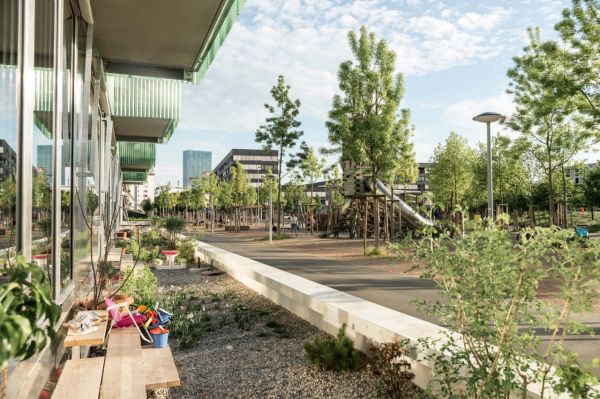
To ensure that heat prevention and reduction measures are implemented in practice, heat-adapted residential development must be incorporated into urban planning and building laws. Future development can also be guided by building owners defining requirements to that effect in architecture competitions. Larger-scale building owners, in particular, have recognised that heat reduction measures are an important factor in achieving high liveability standards and are thus advantageous in real estate marketing.
It’s not just exterior spaces that need to be planned and built in a climate-conscious way, but also the buildings themselves. In order for them to offer the desired liveability standards in 50 or 100 years, despite the hotter climate, their interiors must remain as cool as possible even in prolonged heat. To achieve this without cooling devices, which consume electricity and additionally warm the surrounding environment with waste heat, design parameters such as building orientation, window surfaces and the building’s retention capacity are critical. Solid ceilings and floors, for example, store heat due to their mass and room temperatures rise more slowly.
A particular focus of climate-conscious building planning are windows. Large-scale glazing is beneficial in that it lets abundant natural daylight into the interior and keeps solar heat input high in winter. In summer, however, this heat is undesirable. It is therefore recommended to avoid floor-to-ceiling windows as far as possible, and to strike a balance between aesthetics and comfortable temperatures. A window proportion of up to 30 per cent in residential buildings and up to 40 per cent in office buildings is a benchmark.
Ventilation and cooling
During long periods of hot weather, even a well-planned building heats up. It is extremely effective to dissipate the accumulated heat at night. This can be achieved by cross-ventilation, for example. Even better is to design a building that develops a chimney effect. Ventilation flaps in the façade – adjacent to the windows, for example – allow cool outside air to enter the interior and then discharge through an opening in the roof by way of the stairwell. Such solutions incur no or only minimal additional costs and work more efficiently than air conditioning. Unlike residential buildings, today’s office buildings are often equipped with cooling systems. This is due to the high internal loads produced by users and IT infrastructure, not to mention the high proportion of glass in the façades. There are office buildings whose requirements for cooling and heating energy are now already identical. By 2100, office buildings could require up to ten times more energy for cooling than for heating, depending on climatic developments. This would presumably increase operating costs significantly and make it more difficult to operate buildings economically.
Environmentally friendly passive cooling is ideal for meeting the basic cooling requirements of office and residential properties. Known as free cooling, there are various energy sources in Switzerland that are suitable for this. Geothermal heat accessed via probes is often used. In winter, thermal energy from the ground is used as a heat source, while in summer it serves also for cooling, because required temperatures are significantly below room temperatures. Lake water is another particularly suitable energy source, as the many Swiss lakes provide a valuable thermal storage mass. Because their shores are often densely populated, the lake water can be efficiently used to supply numerous buildings. Whether it comes from geothermal probes, lake water or other sources, it is crucial that cooling uses as little energy as possible. Building owners, investors and architects should therefore address this area in good time and check which options are feasible. This enables the construction of buildings that can offer high comfort levels even in the hot summers of the future, without placing an additional burden on the environment. An interesting example of this is the energy solution for the Côté Parc site in Geneva.

Environmentally friendly heating remains important
It is important to bear in mind that the cooling energy needed for residential buildings is relatively low compared to the heating required. Decarbonisation of heat supply must therefore remain a priority in order to achieve net zero. Sustainable heating is not a problem nowadays, with various technically mature and economically attractive renewable heating systems available.
Renewable energy supply is a key aspect if Switzerland is to meet the targets of the Energy Strategy 2050 and reduce its CO₂ emissions. Investors and owners who want to play their part also benefit from appropriate solutions: they receive a commercially attractive solution and a high level of planning security with cost transparency. It is important that they involve energy service providers in their project as early as possible. These use their expertise and experience to identify areas of potential, for example cross-site solutions or combining locally available energy sources. The result is buildings and sites with efficient and sustainable energy solutions that integrate all essential aspects, from photovoltaics to cooling and heat supply to electromobility.
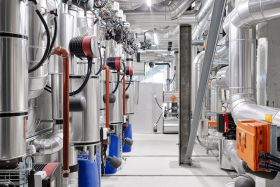


How should we be building today so that buildings can cope with the climate of the future? Our ‘Climate-conscious building’ white paper provides building owners and investors with a knowledge base and inspiration for building against the background of climate change and shows what a renewable energy supply can look like.

